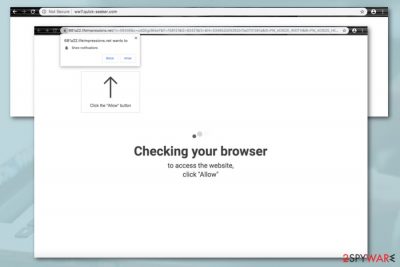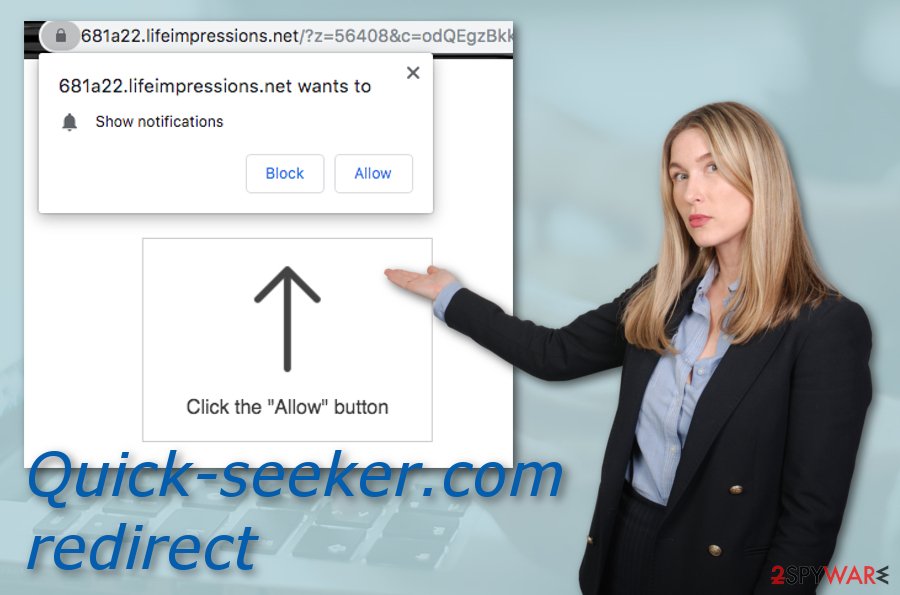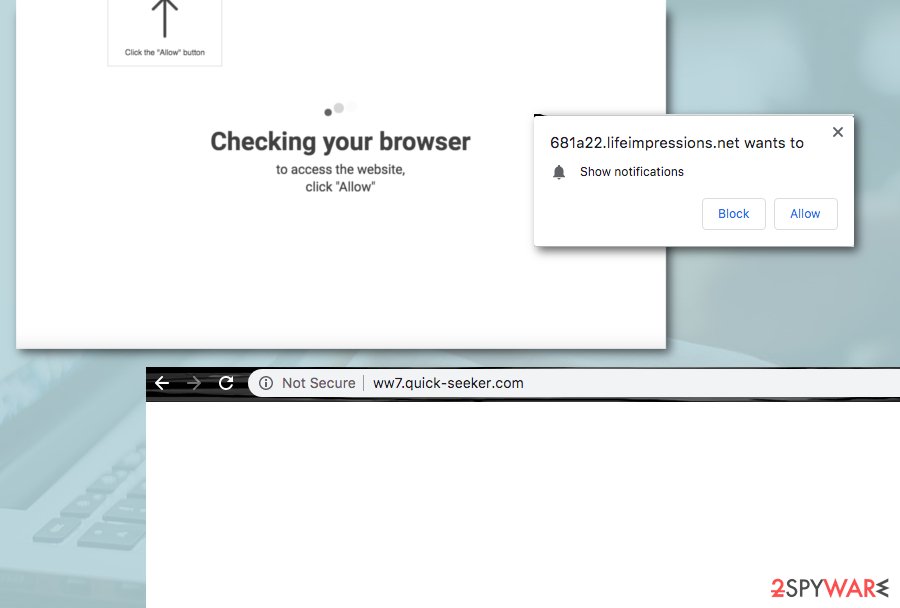Quick-Seeker.com hijack (Removal Guide) - updated Nov 2019
Quick-Seeker.com hijack Removal Guide
What is Quick-Seeker.com hijack?
Quick-Seeker.com – an adware domain that causes redirects to other odd locations such as 681a22.lifeimpressions.net

Quick-Seeker.com is a questionable domain that forces redirects to other potentially suspicious sources such as 681a22.lifeimpressions.net. Also, the odd URL supports adware-based functions such as frequent advertising and deal promoting during browsing sessions, collecting browsing-based data for targeted advertising. Quick-Seeker.com virus might also affect any type of web browser and make unexpected modifications in the homepage and new tab URL directories.
Quick-Seeker.com is not an app to trust even though it holds the danger level of low. However, low does not mean that there are no dangers at all. For example, intense redirecting activities might force you to land on a malware-laden source and get your computer system infected with a dangerous parasite.
| Name | Quick-Seeker.com |
|---|---|
| Type | Adware/PUP |
| Danger level | This rogue app holds the danger level of low, however, it still can cause some indirect damage by redirecting the user to malware-laden locations |
| Redirects | If you ever get this adware installed on your computer, you can get redirected to 681a22.lifeimpressions.net that is another third-party domain |
| Task | The main goal of this potentially unwanted program is to gather income from the pay-per-click technique |
| Removal | You can eliminate the suspicious products with the help of antimalware software or step-by-step guidelines (look at the end of this article) |
| Repair | If you have discovered any compromised system files, you can try restoring them with a tool such as FortectIntego |
In some cases, Quick-Seeker.com and its affiliate domains might appear just occasionally. If you receive ads from this URL rarely, installing an ad-blocking application or blocking the URL in your browser settings might be enough to prevent repeated advertising. For browsers:
- Open the browser that has been loading you ads.
- Find the three dots or lines on the upper right corner of your browser window and click them to open the menu.
- Go to Settings > Advanced.
- Afterward, you should find Notifications under Site Settings.
- Search for Quick-Seeker.com or any other questionable domain and get rid of the PUPs by clicking the remove or disable button.
Quick-Seeker.com might use tracking objects such as HTTP cookies, beacons, and pixels[1] that record your browsing information and can use it for targeted advertising in the future. This way, the developers increase their chances of earning income from the cost-per-click technique[2] (also known as pay-per-click).

Be careful with Quick-Seeker.com pop-up ads as you might be provided with a huge variety of untrustworthy products and services that you truly do not need. This way the adware might even try to promote rogue security software and convince you to buy the product for an inadequate price.
Continuously, Quick-Seeker.com might try to get you involved in various scamming schemes by providing you fake prize claims, surveys, questionnaires, etc. The PUP might ask you to type in personally-identifiable information or even credentials when the main goal is to swindle some money from you.
Our suggestion would be not to provide any sensitive data to Quick-Seeker.com or other PUPs. This way you might find your information breached or your identity stolen if the information falls in the hands of a bad actor. However, the main benefit of adware for third-party developers comes from intrusive advertising.
Intense advertising from Quick-Seeker.com domain might force your browser to suddenly freeze while carrying multiple actions. Nevertheless, many activities that come from this app might also slow down your entire computer system and relate to the high usage of your CPU and GPU work.

Avoid all annoying activities by performing the Quick-Seeker.com removal process automatically or manually. However, note that you have to get rid of the adware not only from your OS but also web browsers such as Chrome, Firefox, Explorer, Edge, and Safari.
Once you remove Quick-Seeker.com from your computer and browser apps, it is time to check for file compromisation as the adware program might have affected some of your system files. If you find signs of compromising, you can try repairing the components with a tool such as FortectIntego.
Promotion techniques of adware apps
PUPs such as adware are promoted via various techniques. You may discover bogus apps installed on your PC without any permission asked. That's because they were added to various free programs as an optional component. If you don't like to monitor the installation of the freeware and simply keep clicking the “Next” button when installing one on your PC system, you can also allow the installation of a questionable product.
That is why we always outline the fact that you should always check what is said in the program's end user's license agreement, privacy policy and other sources of information. In addition, you should also make sure that you select Custom or Advanced installation options and opt-out of such “optional components” as various browser add-ons, extensions,[3] toolbars. and plugins. Of course, you should never agree with the changes in your homepage or default search engine or any other browser/computer settings.
Furthermore, adware programs can get delivered via fake software updates such as Adobe Flash Player or JavaScript. Other spreading ways include secret PUP injection via hyperlinks and advertisements that are loaded on third-party websites. Our point would be to avoid opening any questionable content that you encounter on secondary sources. Also, have an adware app running on your machine for automatical protection and threat detection.
Eliminate Quick-Seeker.com from the computer system/browsers
If you see that Quick-Seeker.com and its activities have already started bothering you frequently, it is time to check your computer. For that, we recommend using a reputable anti-spyware that will help you to check the entire PC system and will also help you to delete all bogus apps.
However, you can remove Quick-Seeker.com with the help of manual step-by-step guidelines too. Below you will find instructions on how to clean your Windows/macOS computer systems and web browsers such as Google Chrome, Mozilla Firefox, Internet Explorer, Microsoft Edge, and Safari.
After Quick-Seeker.com removal, go back to the section where we were talking about necessary steps to avoid adware infections. Memorize them all again and increase your computer safety level to be secure in the upcoming future. Regarding Virusai.lt experts[4] claim, combining both manual and automatical security should work the best for every user.
You may remove virus damage with a help of FortectIntego. SpyHunter 5Combo Cleaner and Malwarebytes are recommended to detect potentially unwanted programs and viruses with all their files and registry entries that are related to them.
Getting rid of Quick-Seeker.com hijack. Follow these steps
Uninstall from Windows
To remove bogus apps from Windows, you should follow the below-provided tasks:
Instructions for Windows 10/8 machines:
- Enter Control Panel into Windows search box and hit Enter or click on the search result.
- Under Programs, select Uninstall a program.

- From the list, find the entry of the suspicious program.
- Right-click on the application and select Uninstall.
- If User Account Control shows up, click Yes.
- Wait till uninstallation process is complete and click OK.

If you are Windows 7/XP user, proceed with the following instructions:
- Click on Windows Start > Control Panel located on the right pane (if you are Windows XP user, click on Add/Remove Programs).
- In Control Panel, select Programs > Uninstall a program.

- Pick the unwanted application by clicking on it once.
- At the top, click Uninstall/Change.
- In the confirmation prompt, pick Yes.
- Click OK once the removal process is finished.
Delete from macOS
Remove items from Applications folder:
- From the menu bar, select Go > Applications.
- In the Applications folder, look for all related entries.
- Click on the app and drag it to Trash (or right-click and pick Move to Trash)

To fully remove an unwanted app, you need to access Application Support, LaunchAgents, and LaunchDaemons folders and delete relevant files:
- Select Go > Go to Folder.
- Enter /Library/Application Support and click Go or press Enter.
- In the Application Support folder, look for any dubious entries and then delete them.
- Now enter /Library/LaunchAgents and /Library/LaunchDaemons folders the same way and terminate all the related .plist files.

Remove from Microsoft Edge
Delete unwanted extensions from MS Edge:
- Select Menu (three horizontal dots at the top-right of the browser window) and pick Extensions.
- From the list, pick the extension and click on the Gear icon.
- Click on Uninstall at the bottom.

Clear cookies and other browser data:
- Click on the Menu (three horizontal dots at the top-right of the browser window) and select Privacy & security.
- Under Clear browsing data, pick Choose what to clear.
- Select everything (apart from passwords, although you might want to include Media licenses as well, if applicable) and click on Clear.

Restore new tab and homepage settings:
- Click the menu icon and choose Settings.
- Then find On startup section.
- Click Disable if you found any suspicious domain.
Reset MS Edge if the above steps did not work:
- Press on Ctrl + Shift + Esc to open Task Manager.
- Click on More details arrow at the bottom of the window.
- Select Details tab.
- Now scroll down and locate every entry with Microsoft Edge name in it. Right-click on each of them and select End Task to stop MS Edge from running.

If this solution failed to help you, you need to use an advanced Edge reset method. Note that you need to backup your data before proceeding.
- Find the following folder on your computer: C:\\Users\\%username%\\AppData\\Local\\Packages\\Microsoft.MicrosoftEdge_8wekyb3d8bbwe.
- Press Ctrl + A on your keyboard to select all folders.
- Right-click on them and pick Delete

- Now right-click on the Start button and pick Windows PowerShell (Admin).
- When the new window opens, copy and paste the following command, and then press Enter:
Get-AppXPackage -AllUsers -Name Microsoft.MicrosoftEdge | Foreach {Add-AppxPackage -DisableDevelopmentMode -Register “$($_.InstallLocation)\\AppXManifest.xml” -Verbose

Instructions for Chromium-based Edge
Delete extensions from MS Edge (Chromium):
- Open Edge and click select Settings > Extensions.
- Delete unwanted extensions by clicking Remove.

Clear cache and site data:
- Click on Menu and go to Settings.
- Select Privacy, search and services.
- Under Clear browsing data, pick Choose what to clear.
- Under Time range, pick All time.
- Select Clear now.

Reset Chromium-based MS Edge:
- Click on Menu and select Settings.
- On the left side, pick Reset settings.
- Select Restore settings to their default values.
- Confirm with Reset.

Remove from Mozilla Firefox (FF)
To reverse Mozilla Firefox back to its previous state, carry out these instructions:
Remove dangerous extensions:
- Open Mozilla Firefox browser and click on the Menu (three horizontal lines at the top-right of the window).
- Select Add-ons.
- In here, select unwanted plugin and click Remove.

Reset the homepage:
- Click three horizontal lines at the top right corner to open the menu.
- Choose Options.
- Under Home options, enter your preferred site that will open every time you newly open the Mozilla Firefox.
Clear cookies and site data:
- Click Menu and pick Settings.
- Go to Privacy & Security section.
- Scroll down to locate Cookies and Site Data.
- Click on Clear Data…
- Select Cookies and Site Data, as well as Cached Web Content and press Clear.

Reset Mozilla Firefox
If clearing the browser as explained above did not help, reset Mozilla Firefox:
- Open Mozilla Firefox browser and click the Menu.
- Go to Help and then choose Troubleshooting Information.

- Under Give Firefox a tune up section, click on Refresh Firefox…
- Once the pop-up shows up, confirm the action by pressing on Refresh Firefox.

Remove from Google Chrome
To clean Google Chrome from browser helper objects, apply these instructions:
Delete malicious extensions from Google Chrome:
- Open Google Chrome, click on the Menu (three vertical dots at the top-right corner) and select More tools > Extensions.
- In the newly opened window, you will see all the installed extensions. Uninstall all the suspicious plugins that might be related to the unwanted program by clicking Remove.

Clear cache and web data from Chrome:
- Click on Menu and pick Settings.
- Under Privacy and security, select Clear browsing data.
- Select Browsing history, Cookies and other site data, as well as Cached images and files.
- Click Clear data.

Change your homepage:
- Click menu and choose Settings.
- Look for a suspicious site in the On startup section.
- Click on Open a specific or set of pages and click on three dots to find the Remove option.
Reset Google Chrome:
If the previous methods did not help you, reset Google Chrome to eliminate all the unwanted components:
- Click on Menu and select Settings.
- In the Settings, scroll down and click Advanced.
- Scroll down and locate Reset and clean up section.
- Now click Restore settings to their original defaults.
- Confirm with Reset settings.

Delete from Safari
Remove unwanted extensions from Safari:
- Click Safari > Preferences…
- In the new window, pick Extensions.
- Select the unwanted extension and select Uninstall.

Clear cookies and other website data from Safari:
- Click Safari > Clear History…
- From the drop-down menu under Clear, pick all history.
- Confirm with Clear History.

Reset Safari if the above-mentioned steps did not help you:
- Click Safari > Preferences…
- Go to Advanced tab.
- Tick the Show Develop menu in menu bar.
- From the menu bar, click Develop, and then select Empty Caches.

After uninstalling this potentially unwanted program (PUP) and fixing each of your web browsers, we recommend you to scan your PC system with a reputable anti-spyware. This will help you to get rid of Quick-Seeker.com registry traces and will also identify related parasites or possible malware infections on your computer. For that you can use our top-rated malware remover: FortectIntego, SpyHunter 5Combo Cleaner or Malwarebytes.
How to prevent from getting adware
Protect your privacy – employ a VPN
There are several ways how to make your online time more private – you can access an incognito tab. However, there is no secret that even in this mode, you are tracked for advertising purposes. There is a way to add an extra layer of protection and create a completely anonymous web browsing practice with the help of Private Internet Access VPN. This software reroutes traffic through different servers, thus leaving your IP address and geolocation in disguise. Besides, it is based on a strict no-log policy, meaning that no data will be recorded, leaked, and available for both first and third parties. The combination of a secure web browser and Private Internet Access VPN will let you browse the Internet without a feeling of being spied or targeted by criminals.
No backups? No problem. Use a data recovery tool
If you wonder how data loss can occur, you should not look any further for answers – human errors, malware attacks, hardware failures, power cuts, natural disasters, or even simple negligence. In some cases, lost files are extremely important, and many straight out panic when such an unfortunate course of events happen. Due to this, you should always ensure that you prepare proper data backups on a regular basis.
If you were caught by surprise and did not have any backups to restore your files from, not everything is lost. Data Recovery Pro is one of the leading file recovery solutions you can find on the market – it is likely to restore even lost emails or data located on an external device.
- ^ Tracking Pixel. Ryte Wiki. Relevant info.
- ^ Jake Frankenfield. Cost Per Click (CPC). Investopedia. Tech terms and definitions.
- ^ https://www.techopedia.com/definition/1828/extension. Techopedia. Technology data.
- ^ Virusai.lt. Security and spyware news.























